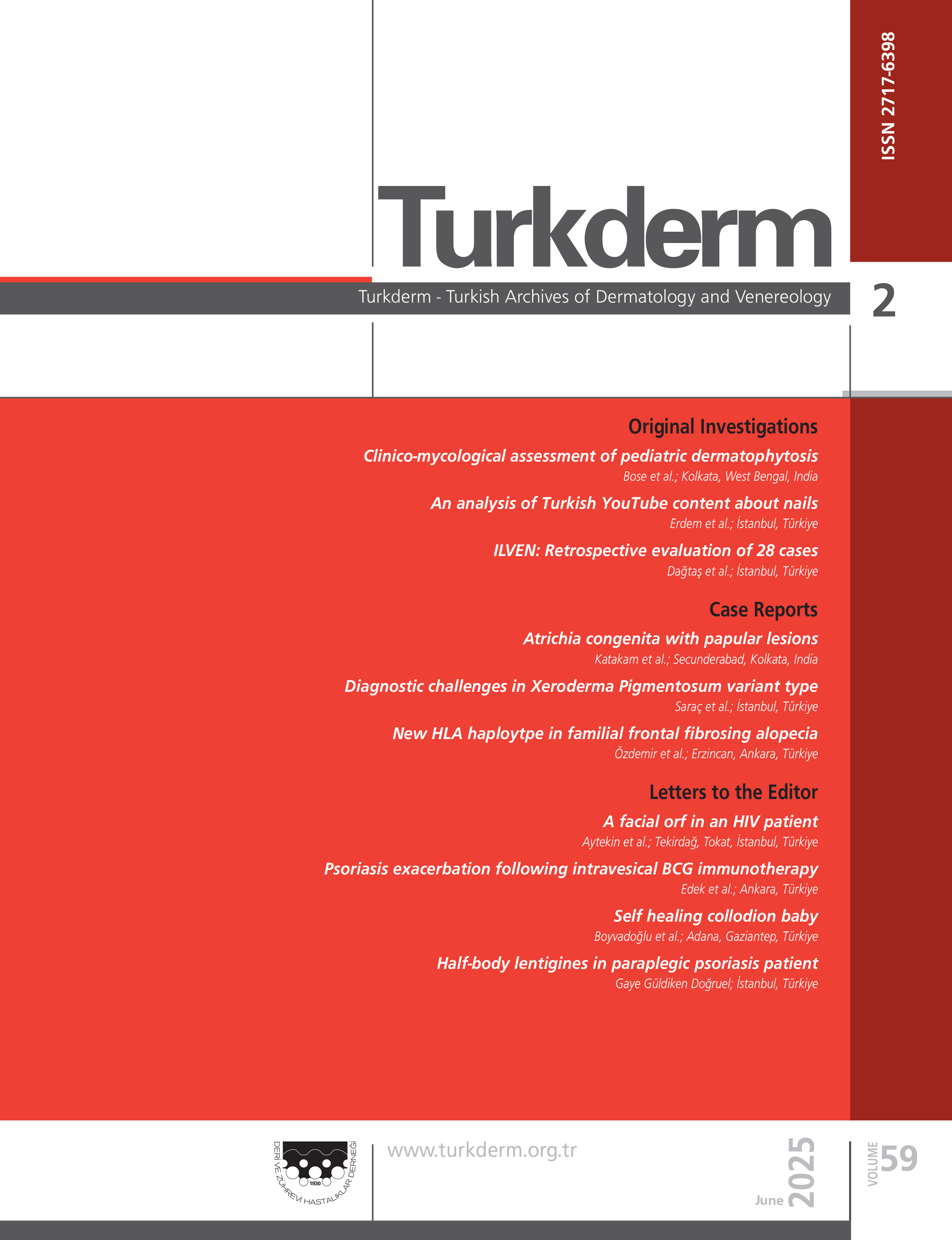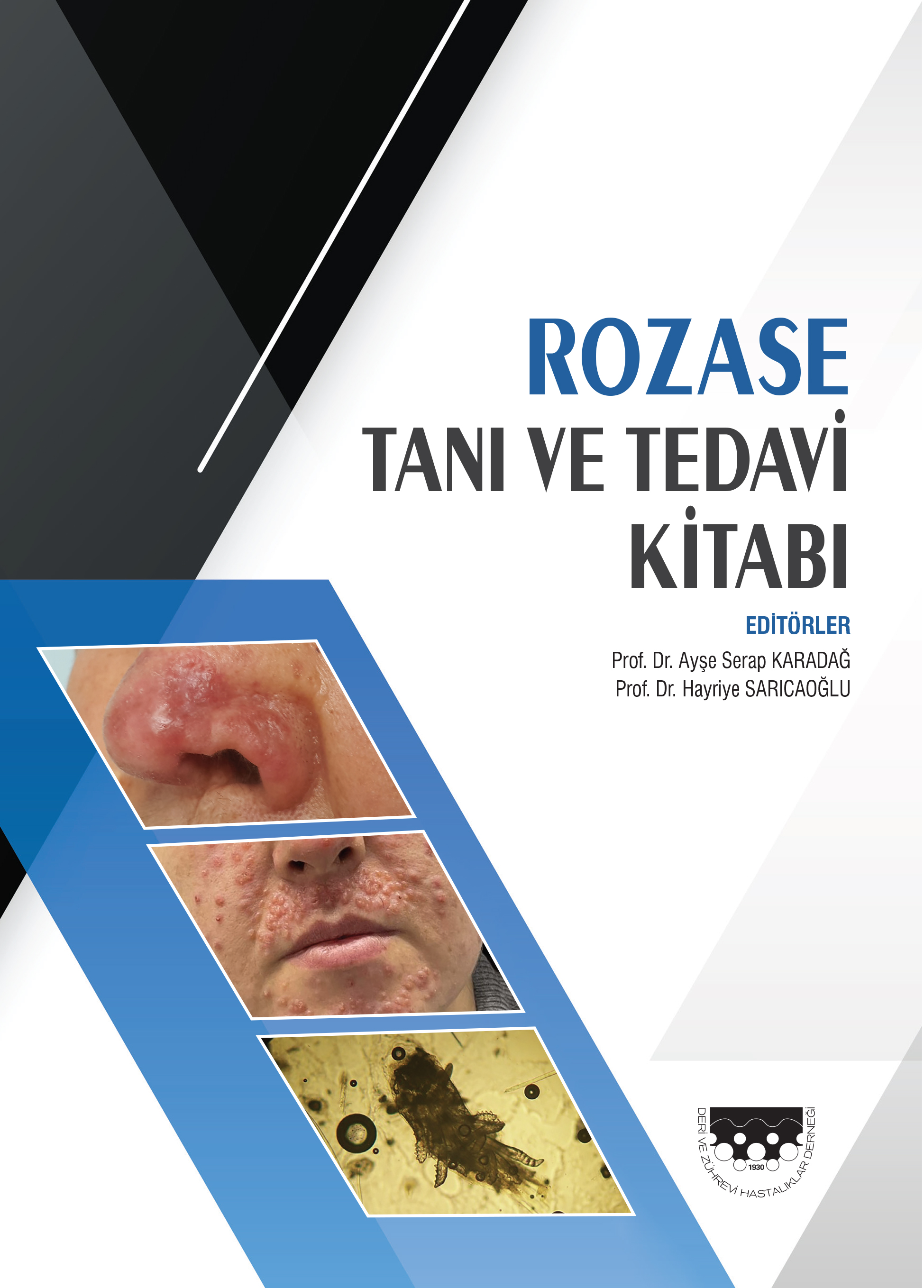Volume: 44 Issue: 3 - 2010
| EDITORIAL | |
| 1. | General Overview of German and Turkish Dermatology Education Meltem Önder doi: 10.4274/turkderm.44.117 Pages 117 - 122 Abstract | |
| REVIEW ARTICLE | |
| 2. | Nail Surgery for Beginners Güneş Gür doi: 10.4274/turkderm.44.123 Pages 123 - 127 Nail diseases have a negative impact on quality of life both by causing esthetic concerns and functional disturbances. Many disorders of the nail require nail surgery for diagnosis and treatment. Dermatologists, however, often refrain from surgical interventions of the nail due to prejudices that they are delicate and hard to perform. Appreciation of nail anatomy will render nail surgical interventions fast and easy with favorable results. Here, nail anatomy and basic nail surgical interventions that we often need to use in everyday practice are discussed. |
| ORIGINAL INVESTIGATION | |
| 3. | Prevalence and Clinical Features of Pressure Ulcers in Patients Receiving Home Health Care Services in the City of Kocaeli Aysun Şikar Aktürk, Erkan Atmaca, Sezai Zengin, Dilek Bayramgürler doi: 10.4274/turkderm.44.128 Pages 128 - 131 Background and Design: In this study, we aimed to determine the prevalence of pressure ulcers and to investigate the clinical features of ulcers and associated factors in patients receiving home health care in the City of Kocaeli. Material and Method: A total of 420 patients, who received home health care by Kocaeli Metropolitan Municipality between August and October 2007, were included in this study. Each patient who had pressure ulcers during this period was assessed from the standpoint of accompanying diseases, nutritional and socioeconomic status, personal cleanliness, existence of incontinence and other factors. In addition, localization, number and clinical stage according to the depth of pressure ulcers were recorded. Results: The prevalence of pressure ulcers was 23.8%. The mean age of the patients was 68 (range: 11- 100) years. Of the patients with pressure ulcers, 49% had cerebrovascular accident and 14% had past history of trauma. Pressure ulcers were found mainly in the sacral region (mean, 72%) and were most commonly in stage 2 (mean, 33%). Conclusion: We determined that the prevalence of pressure ulcers was 23.8%. In our study, similar to other studies, it was observed that decubitus ulcers are still a frequently seen health problem in bedfast and needy patients, even though their occurrence can be prevented by some simple measures. |
| 4. | Prevalence of Dermatosis During Childhood Handan Saçar, Tuncer Saçar doi: 10.4274/turkderm.44.132 Pages 132 - 137 Background and Design: The aim of this study was to determine the distribution of skin diseases during childhood. Material and Method: A retrospective descriptive study was planned. Among 18318 patients referred to our dermatology outpatient clinic between September 2004 and November 2009, 1756 child patients between 0-12 years of age were retrospectively analyzed from automation record system. Results: A total of 1756 child patients who referred during the study period were included in the study; 791 patients were male (45.05%) and 965 were female (54.95%). The most frequently seen disease group was eczema (26.0%), followed by infectious dermatosis (20.6%) and eritematous squamous dermatosis (9.9%). Atopic dermatitis (8.0%), viral dermatosis (11.7%) and seborrheic dermatitis (7.1%) were the most frequently encountered diseases in eczema, infectious dermatosis and eritematous squamous dermatosis groups, respectively. Conclusion: We found that 56.5% of the diseases determined were composed of eczemas, infectious dermatosis and eritematous squamous dermatosis. |
| 5. | Assessment of Sociodemographic and Clinical Features in Patients with Adolescent and Post-adolescent Acne Safiye Kutlu, İlknur Kıvanç Altunay, Adem Köşlü, Sevim Purisa doi: 10.4274/turkderm.44.138 Pages 138 - 142 Background and Design: Acne is an inflammatory disease of the pilosebaceous follicle and is generally accepted as a disorder of the adolescence period. However, an increased frequency during post-adolescence has been reported recently, especially in adult women. We aimed to compare sociodemographic and clinical features of patients with adolescent and post-adolescent acne in order to determine whether there are differences between these two groups. Material and Method: Üç yüz on dört patients diagnosed as acne were included in the study. All patients were asked about demographical information, family history, drug use, presence of stress, cosmetic and diet association, and in women, presence of hyperandrogenic findings and a premenstrual flare-up of acne. Results: 46.8% of patients had adolescent acne and 53.1% post-adolescent acne. Of the patients with post-adolescent acne, 143 (85.6%) were women and 24 (14.3%) men. In both adolescent and post-adolescent groups, women and single patients had more acne than the others and the clinical severity of acne was similar. Cheeks, nose, forehead and back involvements were more common in adolescents, while perioral area and neck were affected mostly in post-adolescence. In adult women, there was no difference regarding prevalence of hyperandrogenic findings, except androgenetic alopecia. The increased frequency in acne correlated significantly with stress, cosmetic applications, and premenstrual flare-up in post-adolescent women, while diet association was more common in the adolescent group. Conclusion: Adolescent and post-adolescent acne show some differences with regard to sociodemographic and clinical eatures. Each group needs to be evaluated individually. It is important to determine these differences for precautions and therapeutic approach. |
| 6. | Investigation of Frequency of Allergic Contact Dermatitis Due to Cosmetics in Patients with Acne Vulgaris İpek Gürses Koç, Pınar Yüksel Başak doi: 10.4274/turkderm.44.143 Pages 143 - 149 Background and Design: Acne vulgaris is a chronic inflammatory disease of pilosebaceous unit. While some cosmetic products can trigger acne, topical and cosmetic agents used in the treatment of acne may cause allergic contact dermatitis. Therefore, the choice of cosmetic products is very important for the patients. Limited number of studies have been found in literature investigating allergic contact dermatitis due to only topical drugs in patients with acne vulgaris. Material and Method: In this research, it is aimed to find out the frequency of allergic contact dermatitis caused by cosmetics in patients with acne vulgaris. Fifty patients with acne vulgaris but without clinical signs of contact dermatitis and 50 control cases without contact dermatitis on admittance were included in the study. Skin patch tests of the European standard series (27 allergens) and cosmetic series (45 allergens) with IQ Chamber test materials were applied on the unlesional back of the patient and control groups. Materials with testing substances were taken out of skin 48 hours later and read after 30 minutes and at 72nd hour, as suggested by International Contact Dermatitis Research Group, and substances leading to reactions were recorded. Results: Sensitivity to sorbitan monooleate, in the cosmetic series, was found to be significantly higher in the patient group (p=0,022). While no statistical difference except for sorbitan monooleate was detected in the patient and control groups, it was found that the patient group reacted positively to more allergens than the controls. Conclusion: In conclusion, because of abundance of allergens detected with patch test in the patient group, it may be suggested that cosmetic products might be responsible for the development of allergic contact dermatitis in patients with acne vulgaris. In addition, we believe that furthering studies with groups of numerous patients are needed to support our results. |
| 7. | Clinical Comparison of Aphthae in Recurrent Aphthous Stomatitis and Behçet's Disease Şule Güngör, Gülfer Akbay, Meral Ekşioğlu doi: 10.4274/turkderm.44.150 Pages 150 - 152 Background and Design: To compare the oral ulcerations and other clinical features seen in recurrent aphthous stomatitis (RAS) and Behçets disease (BD). Material and Method: Thirty RAS patients (20 female, 10 male), aged 20-54 years and 49 Behçet patients (32 female, 17 male), aged 19-47 years, were included in the study. Diagnosis of RAS was made in the patients who have oral ulcerations more than 3 times per year, and who does not suffer from diseases, which may cause aphthous or aphthous-like lesions. The diagnosis of BD was established according to the criteria of the International Study Group for BD. Both groups were examined for family history, age at onset, disease duration, frequency and duration of oral aphtae; additionally, during dermatological examination, dimension, localization and number of oral aphthae were recorded. Students t-test and Mann-Whitney U tests were used for statistical analysis. Results: The mean age at onset of the disease was lower in Behçet patients than in RAS patients, and this difference was statistically significant. Conclusion: Although BD is usually considered as the initial diagnosis in cases of recurrent oral ulcerations starting at young ages and in presence of multiple oral ulcerations, and RAS is the more probable diagnosis in patients with ulcerations on the labial mucosa, further studies in a larger population are needed on this topic. |
| 8. | Serum Iron and Ferritin Levels in Patients with Vitiligo Ayşe Tülin Mansur, İkbal Esen Aydıngöz, Fatih Göktay, Sacide Atalay doi: 10.4274/turkderm.44.153 Pages 153 - 155 Background and Design: In recent years, the role of oxidative stress in vitiligo has been widely investigated. Iron and ferritin have important roles in inflammation and oxidative reactions. However, up to date, there are very limited studies on iron metabolism in patients with vitiligo. In this study, we aimed to investigate serum iron and ferritin levels in patients with localized and generalized vitiligo in comparison with a control group. Material and Method: The study groups comprised 68 patients with vitiligo who did not receive systemic treatment or phototherapy in the preceding month, and 72 age- and sex-matched patients with skin disorders other than vitiligo including tinea pedis, melanocytic nevi, and keratoses. Blood samples for serum iron and ferritin levels were obtained before breakfast, after verbal informed consent. Results: No statistically significant differences were found between vitilligo patients and control population with regard to serum levels of iron and ferritin (p=0.478, p=0.307). Patients with localized and generalized vitiligo were also similar for these parameters (p=0.054, p=0.867). Moreover, serum levels of iron and ferritin did not show any significant correlation with disease duration (p=0.382, p=0.485). Conclusion: Our results showed that serum iron and ferritin levels were similar in patients with vitiligo and control subjects. Further studies determining the skin levels of iron and ferritin may elucidate the probable role of these molecules in vitiligo. |
| 9. | The Efficiency of 1064 nm Nd: YAG Laser in the Treatment of Different Types of Verruca Tuncer Saçar, Handan Saçar doi: 10.4274/turkderm.44.156 Pages 156 - 159 Background and Design: The aim of this study was to determine the efficiency of 1064 nm Nd: YAG laser in different types of verruca. Material and Method: A prospective descriptive study was planned. The study group constituted of 198 patients who had referred to the dermatology outpatient clinic between September 2007 and September 2008 with warts located at different sites and not previously treated. Results: Of the 198 patients aged 7-65 years who applied to our outpatient clinic during the study, 83 (41.9%) were female, 115 (58.1%) were male and the female/male ratio was 0.72; the total wart number, the mean wart number, and standard deviation were found to be 1127, 6.59, and 14.28, respectively. The location of warts was as follows: periungual (n=25; 12.6%), facial - plana (n=16; 8.1%), palmar (n=45; 22.7%), plantar (n=70; 35.4%), and genital (n=42; 21.2%). At clinical recovery evaluation, the recovery rate was 97% (range: 75-100%), and the patient satisfaction was found to be 98.5% in recovery rate over 50%. Our results and the rate of side effects overlap with those in the literature. Conclusion: The treatment success ratio with 1064 nm Nd: YAG laser is quite high in comparison with the other treatment methods and its side effects are not too much, except for pain. Being expensive is the disadvantage of the system. We suggest that Nd: YAG laser is the most efficient and time-saving method in patients with needle fear, unwilling to receive longstanding local treatment, and in children. |
| TURKDERM-9860 | |
| 10. | Hypophosphatemic Osteomalacia in Neurofibromatosis Type 1: Insufficiency Fractures Ahmet Yılmaz, Erol Çenesizoğlu, Hakan Beycioğlu doi: 10.4274/turkderm.44.160 Pages 160 - 163 Neurofibromatosis is a group of clinically related systemic disorders characterized by autosomal dominant inheritance. Hypophosphatemia may rarely develop due to phosphorus loss in the urine in a patient with neurofibromatosis type 1. We present here a 42-year-old male patient with neurofibromatosis type 1, who has two-year history of bone pain and fatigue. Hypoproteinemia, very low blood phosphorus level, significant reduction in bone mineral density, and insufficiency fractures of the proximal femurs and left fibula were detected. It was considered that hypophosphatemic osteomalacia led to stress fractures. The fractures were sufficiently healed with bisphosphonate, vitamin D, calcium treatment and phosphorus-rich diet. The blood phosphorus level of the patient approached approximately the normal limits. Long-lasting spinal, arm and leg pain in patients with neurofibromatosis type 1 must be carefully followed. It should be kept in mind that hypophosphatemic osteomalacia may occur in these patients. In addition to systemic examination, measurement of blood phosphorus level and bone mineral density must be done in order to prevent severe morbidities. |
| 11. | A case of Scabies with Lesions Resembling Perforating Folliculitis and Uremic Pruritus Hülya Akgün, Ebru Akay, Pınar Kulluk, Serap Utaş doi: 10.4274/turkderm.44.164 Pages 164 - 166 Scabies is an infestation caused by Sarcoptes scabiei and characterised by polymorphous lesions that may include burrows, papules, pustules, crusts and excoriations. Several pruritic diseases may be confused with scabies. Herein, we present a case of scabies with lesions resembling perforating folliculitis diagnosed on the basis of both clinical and histopathological view. A 72-year-old man with type 2 diabetes mellitus and receiving hemodialysis for ten years due to end-stage renal disease was admitted to our dermatology department with a 6-month history of severe pruritus. Based on the results of skin biopsy revealing Sarcoptes scabiei in the epidermis, the patient was diagnosed as scabies and was successfully treated with 5% permethrin. This case is presented to emphasize that scabies should be considered in the differential diagnosis in cases of chronic pruritus. |
| 12. | Bullous Pemphigoid in a Patient with Psoriasis Treated with Cyclosporine Hande Arda Ulusal, Özlem Su, Filiz Cebeci, Damlanur Sakız, Nahide Onsun doi: 10.4274/turkderm.44.167 Pages 167 - 169 The concomitant occurrence of psoriasis and bullous pemphigoid has been described previously, but the pathogenic mechanism of this relationship is still unknown. We describe a 34-year-old woman with a 22-year history of plaque-type psoriasis. On the third day of hospitalization, disseminated tense bullae developed on her neck and upper extremities. Histologic examination of biopsy specimen obtained from a vesicular lesion demonstrated a subepidermal blister. Direct immunofluorescence revealed IgG and C3 deposition in a linear pattern at the basement membrane zone. Both diseases were successfully treated with cyclosporine. However, the coexistence of these conditions represents a difficult therapeutic challenge. |
| 13. | A Case of Multiple Myeloma Diagnosed by Skin Lesions Fatma Gülru Erdoğan, Burcu Tuğrul, Aysel Gürler, Aylin Okçu Heper doi: 10.4274/turkderm.44.170 Pages 170 - 173 Multiple myeloma, being a malignant proliferation of plasma cells in the bone marrow, has clinical spectrum varying from monoclonal gammopathy with unknown significance to plasma cell leukemia. The presenting symptoms have usually been bone pain, pathologic fractures or repeating infections. In patients with multiple myeloma, amyloid depositions may be seen in the skin. This form, defined as primary systemic amyloidosis, is characterized by light-chain amyloid fibril depositions. Our case applied with multiple, asymptomatic, yellowish papules localized on the face, trunk, oral and genital mucosa, gradually increasing during the last two years. He had no complaints, except for slight weight loss. In routine tests, the patient had no pathological laboratory findings, except high C-reactive protein levels. Further research revealed histopathologic and immunohistochemical findings consistent with amyloidosis. Upon these results, immunoglobulin G levels were measured and found high, and in protein electrophoresis, IgG monoclonal gammopathy was determined. The diagnosis of multiple myeloma is made by bone marrow biopsy. This patient is presented for being an asymptomatic case diagnosed by skin findings of amyloidosis. |
| WHAT IS YOUR DIAGNOSIS? | |
| 14. | What is Your Diagnosis? Gülsüm Gençoğlan, Aylin Türel Ermertcan, Görkem Eskiizmir, Peyker Temiz Pages 174 - 175 Abstract | |
| TURKDERM-6637 | |
| 15. | Society News Page 176 Abstract | |
| NEW PUBLICATIONS | |
| 16. | Treatment of Leg Veins Page 177 Abstract | |























